Operation
PRE-RIDE INSPECTION
- If the Pre-ride Inspection is not performed, severe personal injury or vehicle damage may result.
Inspect your motorcycle every day before you ride. The items listed here will only take a few minutes to inspect, and in the long run they can save time, expense, and possibly your life.
- Engine oil level-add engine oil if required (page 27). Check for leaks.
- Fuel level-fill fuel tank when necessary (page 24). Check for leaks.
- Coolant level-add coolant if required. Check for leaks (pages 22-23).
- Front and rear brakes-check operation; make sure there is no brake fluid leakage, (pages 18-20, 90)
- Tyres-check condition (pages 30-32) and pressure (page 31).
- Throttle-check for smooth opening and full closing in all steering positions.
- Lights and horn-check that headlight, tail/brake light, turn signals, indicators and horn function properly.
- Engine stop switch-check for proper function (page 35).
- Side stand ignition cut-off system-check for proper function (page 95).
Correct any discrepancy before you ride. Contact your authorized Honda dealer for assistance if you cannot correct the problem.
STARTING THE ENGINE
Always follow the proper starting procedure described below.
This motorcycle is equipped with a side stand ignition cut-off system. The engine cannot be started if the side stand is down, unless the transmission is in neutral. If the side stand is up, the engine can be started in neutral or in gear with the clutch lever pulled in. After starting with the side stand down, the engine will stop if the transmission is put in gear before raising the side stand.
- Never run the engine in an enclosed area. The exhaust contains poisonous carbon monoxide gas that can cause loss of consciousness and lead to death.
- Do not flood the engine by twisting the throttle repeatedly. The carburetor has an accelerator pump.
NOTE:
- Do not use the electric starter for more than 5 seconds at a time. Release the starter button for approximately 10 seconds before pressing it again.
Preparation
Before starting, insert the key, turn the ignition switch ON and confirm the following:
- The transmission is in NEUTRAL (neutral indicator light ON).
- The engine stop switch is at
 (RUN).
(RUN). - The ABS Indicator Light, TCS Indicator Light, TCS OFF Indicator and TCS Activation Light are ON (For model equipped with CBS/ABS/TCS. See pages 14-15).
- The red low oil pressure indicator light is ON.
CAUTION:
- The red low oil pressure indicator light should go off a few seconds after the engine starts. If the light stays on, stop the engine immediately and check engine oil level. Operating the engine with insufficient oil pressure can cause serious engine damage.
Starting Procedure
To restart a warm engine, follow the procedure for "High Air Temperature".
Normal Air Temperature 10° - 35°C (50° - 95°F):
- Pull the choke lever back all the way to Fully On (B), if the engine is cold.
- Start the engine, leaving the throttle closed.
NOTE:
- Do not open the throttle when starting the engine with the choke on. This will lean the mixture, resulting in hard starting.
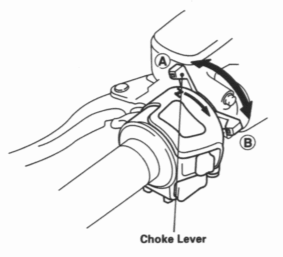
- Immediately after the engine starts, operate the choke lever to keep fast idle at 2,000 - 2,500 min-1 (rpm).
- About a half minute after the engine starts, push the choke lever forward all the way to Fully Off (A).
- If idling is unstable, open the throttle slightly.
High Air Temperature 35°C (95°F) or above:
- Do not use the choke.
- Open the throttle slightly.
- Start the engine.
Low Air Temperature 10°C (50°F) or below:
- Follow steps 1 - 2 under "Normal Air Temperature".
- When engine speed begins to pick up, operate the choke lever to keep fast idle at 2,000 - 2,500 min-1 (rpm).
- Continue warming up the engine until it runs smoothly and responds to the throttle when the choke lever is at fully OFF (A).
CAUTION:
- Snapping the throttle or fast idling for more than about 5 minutes at normal air temperature may cause exhaust pipe discoloration.
- Extended use of the choke may impair piston and cylinder wall lubrication.
Flooded Engine
If the engine fails to start after repeated attempts, it may be flooded with excess fuel. To clear a flooded engine, leave the engine stop switch on ![]() (RUN) and push the choke lever forward to Fully OFF (A). Open the throttle fully and crank the engine for 5 seconds. If the engine starts, quickly close the throttle, then open it slightly if idling is unstable. If the engine does not start, wait 10 seconds, then follow the "High Air Temperature" Starting Procedure, (page 49)
(RUN) and push the choke lever forward to Fully OFF (A). Open the throttle fully and crank the engine for 5 seconds. If the engine starts, quickly close the throttle, then open it slightly if idling is unstable. If the engine does not start, wait 10 seconds, then follow the "High Air Temperature" Starting Procedure, (page 49)
RUNNING-IN
During initial running-in, newly machined surfaces will be in contact with each other and these surfaces will wear in quickly. Running-in maintenance at 1,000 km (600 miles) is designed to compensate for this initial minor wear. Timely performance of running-in maintenance will ensure optimum service life and performance from the engine.
The general rules are as follows:
- Never lug the engine with full throttle at low engine speeds. This rule is applicable not only during running-in but at all times.
- Maximum continuous engine speed during the first 1,000 km (600 miles) must not exceed 4,000 min-1 (rpm).
- Increase the maximum continuous engine speed by 1,000 min-1 (rpm) between odometer readings of 1,000 km (600 miles) and 1,600 km (1,000 miles). Drive briskly, vary speeds frequently and use full throttle for short bursts only. Do not exceed 6,000 min-1 (rpm).
- Upon reaching an odometer reading of 1,600 km (1,000 miles), you can subject the motorcycle to full throttle operation. However, do not exceed 8,000 min-1 (rpm)
- indicated by the beginning of the tachometer redzone. (Do not let the tachometer needle enter the red zone.)
CAUTION:
- Running the engine beyond recommended maximum engine speed (the beginning of the tachometer red zone) can damage the engine.
RIDING
Review Motorcycle Safety (pages 1-6) before you ride.
NOTE:
- Make sure the function of the side stand mechanism (See MAINTENANCE SCHEDULE on page 66 and explanation for SIDE STAND on page 95.)
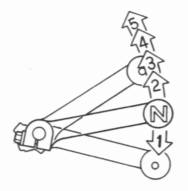
Proper shifting will provide better fuel economy.
- Do not downshift when traveling at a speed that would; the engine to overrev in the next lower gear; the rear may lose traction, resulting in a possible loss of vehicle control.
CAUTION:
- Do not shift gears without disengaging the clutch and closing the throttle. The engine and drive train could be damaged by overspeed and shock.
- Do not tow the motorcycle or coast for long distances while the engine is off. The transmission will not be properly lubricated and damage may result.
- Do not run the engine at high rpm with the transmission neutral or the clutch lever pulled in. Serious engine damage may result.
NOTE:
- Be careful when revving the engine or accelerating in 1st or 2nd gear as the engine speed will easily exceed redline.
BRAKING
This motorcycle is equipped with hydraulically-actuated disc brakes.
Operation - Both Models:
For normal braking, apply both the brake pedal and lever while downshifting to match your road speed. For maximum braking, close the throttle and firmly apply the pedal and the lever; pull in the clutch lever before coming to a complete stop to prevent stalling the engine.
Important Safety Reminders:
- Independent use of only the front or rear brake reduces stopping performance.
- When possible, reduce speed or brake before entering a turn; abruptly closing the throttle or braking hard in mid-turn may cause loss of traction which will reduce control of the motorcycle.
- When riding in wet or rainy conditions, or on loose surfaces, the ability to maneuver and stop will be reduced. All of your actions should be smooth under these conditions. Rapid acceleration, braking or turning may cause loss of control. For your safety, exercise extreme caution when braking, accelerating or turning.
- When descending a long, steep grade, use engine compression braking by downshifting, with intermittent use of both brakes. Continuous brake application can overheat the brakes and reduce their effectiveness.
- Riding with your foot resting on the brake pedal or your hand on the brake lever may actuate the brake light, giving a false indication to other drivers. It may also overheat the brakes, reducing effectiveness.
System Description and Additional Operation - Standard Model:
The non-CBS/ABS/TCS model is equipped with separate hydraulic systems for the front brakes and rear brakes, like any conventional motorcycle.
Remember, extreme braking may cause either wheel to lock, reducing control of the motorcycle.
System Description and Additional Operation - CBS/ABS/TCS Model:
The CBS/ABS/TCS model is equipped with a Dual Combined Brake System. Operating the front brake lever applies the front brake and a portion of the rear brake. Operating the rear brake pedal applies the rear brake and a portion of the front brake. For full braking effectiveness, use both the lever and pedal simultaneously, as you would with a conventional motorcycle braking system.
This model is also equipped with an Anti-lock Brake System (ABS) designed to help prevent wheel lock up during hard braking or during braking on uneven or other poor surfaces while running straight. Although the wheel may not lock up - if you are braking too hard in a turn the motorcycle can still lose traction, causing loss of control.
In some situations, a motorcycle with ABS may require a longer stopping distance to stop on loose or uneven surfaces than an equivalent motorcycle without ABS.
ABS cannot make up for road conditions, bad judgment, or improper operation of the brakes. It is still your responsibility to ride at reasonable speeds for weather, road surface, and traffic conditions, and to leave a margin of safety.
ABS is self-checking and always on.
NOTE
- ABS may be activated by riding over a sharp drop or rise in the road level.
- It is important to follow the tyre recommendations (see page 31). The ABS computer works by comparing wheelspeed. Non-recommended tyres can affect wheelspeed and may confuse the ABS computer.
- ABS does not function at low speeds (approximately 7 km/h or below).
- ABS does not function if the battery is discharged.
ABS Indicator Light
Normally, this light comes on when the ignition is turned ON and goes off after starting to ride (see page 15). If there is an ABS problem, the indicator light comes on and remains on - or blinks. The ABS system does not operate when the ABS indicator light is on or blinking.
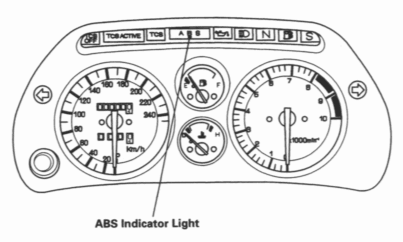
If the ABS indicator light blinks while riding, stop the motorcycle in a safe place and turn off the engine. Turn the ignition ON again. The light should come on, and then go off after starting to ride. If it does not go off or if it blinks again, ABS is not functioning, but the brakes still work a Dual Combined Brake System and provide normal stopping ability. However, you should have the system checked by an authorized Honda dealer as soon as possible.
NOTE
- The ABS indicator light may blink if you turn the rear wheel, placing the motorcycle upright on the stand. This is normal. Turn the ignition OFF to stop the blinking.
CAUTION
- Two red bulbs are used for the ABS indicator light. Be sure that both bulbs light when the ignition is ON. If either or both bull fail to light. See your authorized Honda dealer.
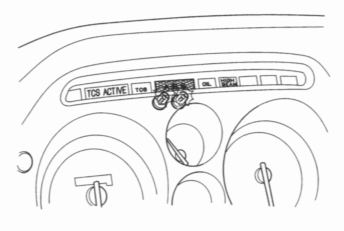
ABS/TCS Indicator Light Switch
To dim the intensity of the blinking ABS Indicator Light, push the ABS/TCS Indicator Light Switch.
- Do not operate the switch while riding the motorcycle. Operating the motorcycle with one or both hands away from the handlebar/controls may result in a loss of vehicle control.
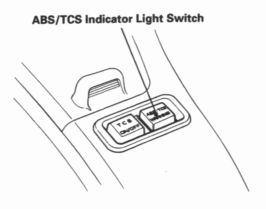
TRACTION CONTROL SYSTEM (TCS)
For model equipped with CBS/ABS/TCS:
The Traction Control System (TCS) assists you in maintaining traction while accelerating on slippery surfaces by regulating the engine's power output when it senses the rear wheel starting to lose traction.
TCS automatically turns on when the ignition is turned ON. You have the option of turning TCS off by using the TCS ON/OFf Switch (see page 59).
Riding with TCS requires no special skills or techniques. TCS does not affect braking and cannot prevent loss of traction if you enter a corner too fast. It is still your responsibility to ride at reasonable speeds for weather, road surface, and traffic conditions, and to leave a margin of safety.
When riding on loose, slippery, or uneven surfaces, you may notice the engine does not respond to the throttle in the same way it usually does. This is a sign that TCS is activated and operating. The TCS Activation Light will flash on to signal you.
NOTE:
- Engine intake and exhaust noise may change when the TCS active.
- TCS may be activated by riding over a sharp drop or rise in the road level.
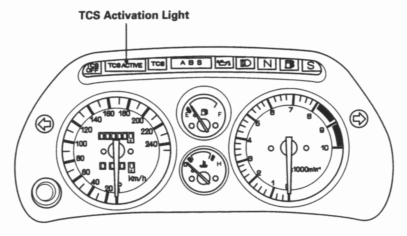
TCS ON/OFF Switch
This switch lets you turn TCS on or off.
Before you begin riding or while parked, you may choose to turn TCS off by pressing the TCS ON/OFF Switch. (You cannot turn TCS off if the motorcycle is moving.) The TCS OFF Indicator comes on. If TCS is off, turn it on by pressing the switch.
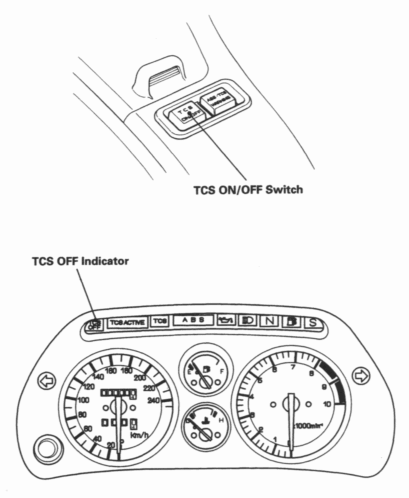
TCS Indicator Light
Normally, this light comes on when the ignition is turned ON and goes off after starting to ride (see page 15). If there is a TCS problem, the indicator light comes on and remains on - or blinks. The system does not operate when the TCS indicator light is on or blinking.
If the TCS indicator light blinks while riding, stop the motorcycle in a safe place and turn off the engine. Turn the ignition ON again. The light should come on, and then go off after starting to ride. If it does not go off or if it blinks again, TCS is not functioning. You can drive the motorcycle without TCS. However, have the system checked by an authorized Honda dealer as soon as possible.
NOTE:
- When the TCS indicator light blinks, TCS is automatically disabled and the TCS OFF indicator turns on.
- The TCS indicator light may blink if you turn the rear wheel placing the motorcycle upright on the stand. This is normal. Turn the ignition OFF to stop the blinking.

ABS/TCS Indicator Light Switch
To turn off the blinking TCS Indicator Light, push the ABS/TCS Indicator Light Switch.
- Do not operate the switch while riding the motorcycle. Operating the motorcycle with one or both hands away from the handlebar/controls may result in a loss of vehicle control.
NOTE:
- The TCS OFF indicator remains ON after the TCS indicator light is off.
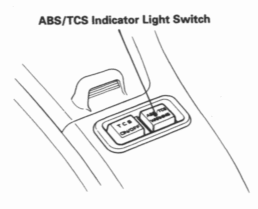
PARKING
- After stopping the motorcycle, shift the transmission into neutral, turn the ignition switch OFF and remove the key.
- Use the side or center stand to support the motorcycle while I parked.
CAUTION:
- Park the motorcycle on firm, level ground to prevent it from falling over.
- Lock the steering to help prevent theft (page 37).
ANTI-THEFT TIPS
- Always lock the steering and never leave the key in the ignition switch. This sounds simple but people do forget.
- Be sure the registration information for your motorcycle is accurate and current.
- Park your motorcycle in a locked garage whenever possible.
- Use an additional anti-theft device of good quality. When you park your motorcycle, we recommend that you secure it by using the securing point and a commercially available chain and lock or equivalent.
- Put your name, address, and phone number in this Owner's Manual and keep it on your motorcycle at all times. Many times stolen motorcycles are identified by information in the Owner's Manuals that are still with them.
NAME: _______________________________________ ADDRESS: _____________________________________ ______________________________________________ ______________________________________________ PHONE NO: ____________________________________